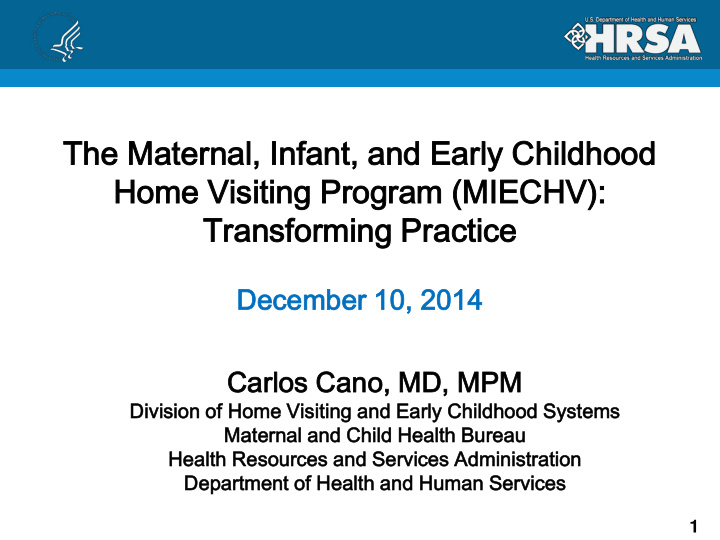



Th The e Ma Mate terna nal, l, In Infa fant nt, , an and d Ea Early ly Chi hild ldho hood od Hom ome e Vis isiting iting Prog ogram ram (MIECHV): MIECHV): Tran Tr ansforming sforming Pr Prac actice tice Decembe ber r 10, 2014 Carlos os Cano, , MD, MPM PM Divis ision on of H Home me Visiting ing and d Early rly Childhood ldhood Syst stem ems s Mater erna nal and d Child ld Heal alth th Bu Bureau reau Heal alth th Reso sources rces and d Serv rvices ices Administra inistration ion Departme partment nt of Heal alth h and Human man Serv rvic ices es 1
Main in Po Point ints • Why a National HV program was needed and how it was created • What has been the progress in implementation to date • Areas where a public-private partnership can generate leverage • Integrate data-based decision making and QI into ongoing program implementation 2
Creating eating Connections onnections Fa Fast 3
Chil Ch ild He Healt lth and De Develo lopment ment Traject ectorie ries Toxic Stress Lack of health services “Healthy” Trajectory Poverty Ready to learn “At Risk” Trajectory Pre-school Health Services Appropriate Discipline Reading to child Parent education Emotional Health Literacy Birth Late Infancy Late Toddler Late Preschool Age 6 mo 12 mo 18 mo 24 mo 3 yrs 5 yrs Early Infancy Early Toddler Early Preschool 4
Why Do Do W We Ne Need a Na Nationa nal Ho Home Vi Visit iting ing Pr Program? gram? Early childhood is a critical time in a child’s life and brain development • Evidence-based HV services have proven effective • All parents can benefit from support around the time of birth and • during the early years of life The e home me is the first st and most st importan portant lear arning ng envir vironme nment nt • Benefits for at-risk populations • • HV reduces some barriers to service engagement • Shapes the intervention to family’s specific needs • Provides “window” into the child’s most proximate environment • Models “relationship building” • “Coaches” parent to enhance knowledge of child development, parental skills and capacity to achieve economic or educational goals 5
Legislative gislative Au Authority thority • Affordable Care Act of 2010 • Amended Title V o V of th the So Soci cial al Se Securi curity ty Ac Act • Section 511: MIECHV • $1.5 billion over 5 years • $100M FY2010 • $250M FY2011 • $350M FY2012 • $400M FY2013 • $400M FY2014 • Sustainable Growth Rate (SGR) Legislation • $400M FY2015 6
Progress ogress to to Date te • Formula/competitive grants in 50 states, DC, and 5 territories • Cooperative agreements w/ 25 tribal entities • Locally designed and run by local organizations in the community (LIAs) • Preliminary data: • Sustained increase from 2012 to 2014 in counties covered, families served, home visits delivered 7
Sta tate te MIE IECH CHV 8
In Innovations novations • Targeting direct service investments towards well- researched and effective home visiting models • HV not just a program but a means to strengthen early childhood services in general (e.g., centralized intake) • Extensive measurement across three areas to track and improve outcomes : performance, evaluation and QI • Articulating a set of common constructs within the six programmatic benchmark areas and requiring grantee measures to assess progress • Supporting ongoing program evaluation and research • Supporting QI efforts to rapidly enhance practice and outcomes, e.g., the HV Collaborative Improvement & Innovation Network 9
Fo Focus us on Outco comes es: Pe Perfor orman ance ce Measur ureme ment nt Data Collection on Program Goals (Benchmark Areas) 1. Prenatal, maternal, and newborn health (8 constructs) 2. Child health and development, including the prevention of child injuries and maltreatment (7) 3. 3. School ool readin ines ess s and acad ademic emic achie ieveme vement nt (9) 4. Crime (2) or domestic violence (3) 5. Family economic self-sufficiency (3) 6. 6. Refer erral rals/ s/pro provi vision sion of other r communi nity ty suppor ports ts (5) 10
Re Researc arch h & Ev & Evaluati ation on Pr Projec ects ts • ACF • Mother and Infant Home Visiting Program Evaluation (MIHOPE) • Mother and Infant Home Visiting Program Evaluation – Strong Start (MIHOPE – SS) • Home Visiting Evidence of Effectiveness (HomVEE) • Design Options for Home Visiting Evaluation (DOHVE) research, evaluation, data, and CQI technical assistance • Tribal Home Visiting Evaluation Institute (TEI) • Tribal Early Childhood Research Center (TRC) • HRSA • Home Visiting Research Network • Investigator-initiated grants 11
QI QI: : Cl Closing ing the Kn Know-Do Do Ga Gap 12
Ho Home Vi Visitin iting g Co CoIIN IN 18 months Recruit Participants (35 Teams) Topic Areas (Key constructs) Pre-work Develop P P P “Change A D A D A D Package” S S S Expert Spread – LS 1 LS 2 LS 3 Meeting Holding Gains Planning AP1 AP2 Nov May May Group 2015 2014 2014 Expert Support Source: Adapted from Institute for Healthcare Improvement, BTS Collaborative . LS – Learning Session AP – Action Period 13
Opportu rtuni nitie ties s for Philanth Ph nthro ropi pic c Ac Actio ion • Cov overage erage of of at at-risk risk ar area eas • Standardized Measurement System • HV Research Network • QI I Col olla labo borative rative (HV V CoI oIIN) IN) 14
Contact ntact In Infor format mation: ion: Car arlos los Can ano, o, MD MD, , MP MPM Senior Advisor Division of Home Visiting and Early Childhood Systems Maternal and Child Health Bureau, HRSA 301-443-8951 ccano@hrsa.gov 15
Recommend
More recommend